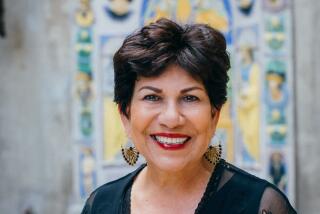Phyllis Patterson dies at 82; co-founder of Renaissance Pleasure Faire
Phyllis Patterson, who with her husband, Ron, originated the Renaissance Pleasure Faire as a summer class in her Laurel Canyon backyard before it grew into a national corset-and-codpiece phenomenon, has died in a Marin County hospital. She was 82.
Patterson, who lived in Novato, had been in declining health before her May 18 death from pneumonia, her son Kevin Patterson said.
In 1960, she left her job as a high school English and history teacher to care for her baby son at home. With all the world a stage, she took a part-time job with a neighborhood youth center doing backyard drama-and-art sessions for fifth- and sixth-graders.
Within a few years, it was no longer about pre-teens pronouncing commedia del’arte and doing elaborate Punch and Judy shows under the oaks. The Pattersons’ effort became the Renaissance Pleasure Faire — a lusty, counter-cultural gathering where thousands in period costume would show up at an old movie ranch to hawk crafts, banter with minstrels, hoist tankards of ale, whirl around a Maypole, gnaw on turkey legs the size of jackhammers and generally make merrie.
::
“The whole idea is to get people to play the living history game,” Patterson told a Times reporter in 1987 as she watched a raucous “hanging procession” wend up a lane lined with thatched huts and crammed pubs. “Our motto is to tickle into learning with a laugh.”
The Pattersons divorced in 1980, but Phyllis continued running the Faire, whose spelling reflected her passion for Elizabethan authenticity. She also banned the sale of plastic goods and came down on performers whose acts weren’t, at least in spirit, 500 years old.
For millions of Americans who didn’t know their meads from their mandolins, the faire was the next big thing. Rock luminaries such as Jimi Hendrix, Jefferson Airplane and Jim Morrison sported “psychedelic fop” fashions. Button-down types like newsman Tom Brokaw headed for the faire on spring Saturdays — “a weekend hippie,” he said in a 2008 interview, with “bell-bottom trousers and sandals.”
Faire-like events started popping up all over.
“If theme parks, with their pasteboard main streets, reek of a bland, safe, homogenized white bread America,” Chicago Sun-Times columnist Neil Steinberg wrote in 2007, “the Renaissance Faire is at the other end of the social spectrum, a whiff of the occult, a flash of danger, and a hint of the erotic. Here, they let you throw axes. Here are more beer and bosoms than you’ll find in all of Disney World.”
Patterson, who, with her husband, acquired 3,000 volumes of Elizabethan history, was ardent about the authenticity of seasonal partying.
“You have to remember that in the 16th and 17th centuries, life expectancy was only about 45 years, and for most it was an accomplishment to just survive the winter,” she said. “People were not just celebrating the changing of the season: They were celebrating the regeneration of life.”
Born Jan. 25, 1932, in Omaha, Phyllis Ann Stimbert grew up in Memphis, Tenn., and received a bachelor’s degree in English from what was Memphis State College. She and her husband, an Air Force officer at a nearby base, married in 1956.
In the late 1950s, they settled in the Bohemian paradise of Laurel Canyon. He was an artist at an ad agency, and she taught in Culver City. They got their first faires off the ground with help from some of their creative neighbors, who had been blacklisted from the film industry, and from sponsor KPFK-FM, the left-leaning radio station.
In subsequent years, they ran into trouble as they tried to find a larger venue in more conservative areas outside Los Angeles.
In 1967, the Ventura County Sheriff’s Office suddenly required fingerprints from crafters who wanted to sell at the faire’s temporary location in Thousand Oaks, wrote Rachel Lee Rubin in “Well Met: Renaissance Faires and the Counterculture” (2012).
“The Pattersons were able to deal with this problem by hastily arranging bus service,” she wrote.
Then county supervisors prematurely shut the fair after hearing testimony about “lewd dances and distribution of literature advocating free love and the use of LSD,” The Times reported.
Patterson denied the accusations and managed to get the event established at Paramount Ranch in the Santa Monica Mountains, where it stayed for 22 years.
“Her approach was very simple,” her son Kevin said. “She came from Tennessee, and she was a schoolteacher. She went into meetings dressed like a teacher, with her hair up and drop earrings, and she treated them like her students until they understood what she was teaching them. She just wore them down — and probably sent them home with a Shakespeare assignment.”
The Pattersons also set up a Northern California faire in Marin County and the Great Dickens Christmas Fair in San Francisco. The family still runs the Dickens event, but the Renaissance faires were sold to a Colorado operator in 1994.
As president of the nonprofit Living History Center, Phyllis Patterson consulted at Old Sturbridge Village in Massachusetts, Colonial Williamsburg in Virginia and elsewhere.
In addition to her son Kevin, Patterson’s survivors include another son, Brian, two grandchildren, and a brother, Vaughn Stimbert. Ron Patterson died in 2011.
Twitter: @schawkins
More to Read
Start your day right
Sign up for Essential California for the L.A. Times biggest news, features and recommendations in your inbox six days a week.
You may occasionally receive promotional content from the Los Angeles Times.







